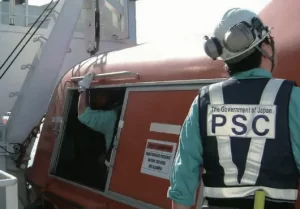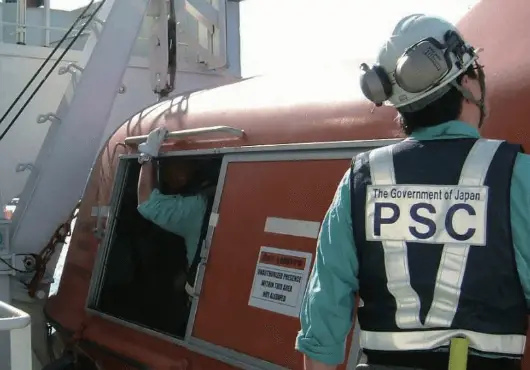
Port State Control (PSC) serves as a critical mechanism to ensure that foreign ships entering a port adhere to international conventions and protocols governing safety, security, and environmental standards. Its primary purpose is to safeguard the well-being of the crew, the protection of the marine environment, and the overall safety of the port.
These inspections are typically conducted by a designated authority known as a Port State Control Officer (PSCO). This officer, representing the maritime authority of the host country, plays a pivotal role in verifying and enforcing compliance with established regulations. PSCOs are trained professionals responsible for assessing ships’ conditions and adherence to international maritime standards, making sure that ships meet the necessary safety, security, and environmental requirements. Port State Control is a vital oversight process that ensures foreign ships arriving at a port are in full compliance with international regulations, with inspections conducted by knowledgeable Port State Control Officers to uphold safety, security, and environmental standards.
Objectives of PSC
Ensure Compliance: One of the primary objectives of Port State Control (PSC) is to guarantee that ships visiting foreign ports adhere to a spectrum of international regulations and conventions. These encompass pivotal agreements like SOLAS (Safety of Life at Sea), MARPOL (Marine Pollution), and the STCW Convention (Standards of Training, Certification, and Watchkeeping for Seafarers). Through rigorous inspections and assessments, PSC verifies that vessels comply with these crucial international standards, promoting maritime safety and environmental protection.
Maintain Safety and Security: PSC also aims to maintain and enhance safety, security, and environmental standards within the maritime industry. This includes the identification and correction of conditions that pose safety risks to seafarers, passengers, and the marine environment. By effectively identifying, rectifying, and deterring hazardous conditions, PSC contributes significantly to the overall safety and security of the shipping industry. It plays a pivotal role in safeguarding not only the interests of shipowners but also the well-being of seafarers, protection of the marine environment, and the safety of the public.
The core objectives of Port State Control encompass ensuring compliance with international regulations and upholding safety, security, and environmental standards in the maritime domain. These objectives collectively contribute to a safer, more secure, and environmentally responsible shipping industry.
Inspection Procedures
Initial Inspection: The initial inspection conducted during Port State Control (PSC) is a comprehensive yet generalized examination of the visiting ship. It primarily focuses on verifying the validity and adequacy of the ship’s certificates, licenses, and essential safety measures. This phase serves as the preliminary assessment to ensure the vessel’s conformity with international maritime regulations and safety standards. It involves a cursory examination of visible safety measures and certificates, helping the Port State Control Officer (PSCO) form an initial impression of the ship’s compliance status.
More Detailed Inspection (Expanded Inspection): The more detailed or expanded inspection, on the other hand, represents a thorough and comprehensive examination that delves into various aspects of the vessel’s operations and documentation. This phase is triggered in specific situations, including instances where deficiencies are identified during the initial inspection or when the ship has a history of repeated detentions. The expanded inspection encompasses a detailed scrutiny of machinery spaces, examination of logbooks, and, in some cases, competency assessments for the crew members. It is a meticulous process aimed at uncovering and rectifying any non-compliance issues and ensuring the ship’s adherence to international maritime standards.
In essence, the inspection procedures within Port State Control involve two crucial phases: the initial inspection, which provides an initial assessment of the ship’s compliance, and the more detailed or expanded inspection, conducted when deficiencies or a history of detentions necessitate a comprehensive examination of the vessel’s operational and safety aspects. These procedures collectively aim to uphold maritime safety, security, and environmental standards in the interest of the global shipping community.
What to Inspect During Port State Control (PSC)
Port State Control inspections encompass a wide range of critical aspects to ensure the safety, security, and environmental compliance of visiting ships. Here’s a comprehensive breakdown of what is inspected:
Ship’s Condition:
- Structural Integrity: Thorough checks are conducted to detect any signs of corrosion, damage, or deformation on vital structural components such as the hull, deck, and superstructure. Ensuring the vessel’s structural soundness is essential for maritime safety.
- Ballast and Cargo Areas: Inspections are carried out to verify proper stowage and securing of cargo, emphasizing the prevention of cargo shifts or damage during transit. Additionally, the functionality of the ballast system is closely examined to ensure it operates as intended, aiding in the vessel’s stability and maneuverability.
- Navigation Lights and Shapes: The condition and adherence to regulations of navigational lights and day shapes are meticulously assessed. This includes verifying that all required lights are operational, correctly positioned, and compliant with international standards. Proper illumination is fundamental for avoiding collisions and ensuring safe navigation.
Crew Competences:
- Certification Checks: Rigorous scrutiny is applied to confirm that the ship’s crew possesses valid certifications pertinent to their designated roles. This includes verifying compliance with Standards of Training, Certification, and Watchkeeping for Seafarers (STCW) certificates. Adequate certification ensures that crew members are proficient in their respective responsibilities.
- Drills and Exercises: The crew’s proficiency in executing safety and security drills is observed during Port State Control inspections. This may include fire-fighting exercises, man-overboard drills, or other emergency procedures. Ensuring that crew members are well-prepared for emergencies is crucial for safeguarding lives and assets at sea.
- Language Proficiency: The ability of crew members to effectively communicate, especially in English, the international language of the sea, is assessed. Language proficiency is vital for smooth and unambiguous communication between crew members and with other vessels or authorities. It contributes to safe and efficient maritime operations.
Port State Control inspections meticulously examine various facets of a visiting ship, including its structural integrity, cargo and ballast handling, navigation equipment, crew certifications, safety drills, and language proficiency. These comprehensive inspections aim to maintain the highest standards of safety, security, and environmental compliance within the maritime industry, promoting the well-being of seafarers and the protection of the marine environment.
Outcomes of Port State Control Inspection
Port State Control (PSC) inspections result in a series of crucial outcomes that determine a ship’s compliance with international maritime regulations and safety standards. These outcomes are pivotal for ensuring the safety of the vessel, its crew, and the marine environment. Here’s an in-depth look at these outcomes:
Inspection Report:
Comprehensive Report: A detailed inspection report is meticulously compiled. This report encompasses the findings of the inspection, including any identified deficiencies and the necessary actions to rectify them. The report serves as an official record of the inspection’s outcomes.
Follow-up Actions:
- Deficiency Correction: The ship operator is legally obligated to address the deficiencies identified during the inspection promptly. These corrective measures are essential to bring the vessel in compliance with international regulations.
- Re-Inspection: In certain cases, the ship may undergo a re-inspection before it is permitted to depart from the port. This re-inspection ensures that the previously identified deficiencies have been effectively resolved, further validating the ship’s compliance.
- PSC Clearance: Depending on the inspection findings, several certifications may be issued to the ship, signaling its compliance status.
- Clean Ship Certificate: This certificate is granted when no deficiencies are discovered during the inspection, signifying that the ship is cleared to proceed without any immediate corrective actions.
- Conditional Clearance: If minor deficiencies are identified but are not considered severe enough to warrant detention, conditional clearance may be granted. These minor issues must be rectified by the time the ship reaches its next port of call.
Verification Requirements:
- Time-Bound Rectifications: In cases where deficiencies are identified, a specific timeline may be provided to the shipowner for rectification. Adherence to this timeline is crucial to ensure timely correction of identified issues.
- Re-Inspection: As part of the verification process, a follow-up inspection may be required to confirm that the identified deficiencies have been successfully addressed, ensuring the ship’s continued compliance with regulations.
Non-Compliance Consequences:
Detentions: Detentions can occur for a range of reasons, including safety-related deficiencies such as faulty lifeboats or environmental issues like improper waste management systems. A detained ship is not permitted to leave port until the identified deficiencies are rectified. PSC authorities are responsible for informing various parties, including the Flag State, the ship owner, and relevant organizations, about the detention. This notification can trigger a series of actions and responses from these entities to address the issues effectively.
Penalties and Sanctions: Non-compliance with PSC regulations can result in specific penalties and sanctions:
-
- Rectification Orders: The ship may receive orders to resolve issues before departing from port. These orders typically do not involve financial penalties levied by the PSC, but non-compliance can lead to detention.
- Port Ban: Repeated detentions may lead to the ship being banned from the port or even from ports within the jurisdiction of that particular PSC region.
- Flag State Consequences: Persistent non-compliance could prompt actions from the Flag State, which may include imposing financial penalties or even revoking certificates such as the Safety Management Certificate (SMC). Classification societies authorized by the Flag State could also withdraw certificates issued on its behalf.
In summary, Port State Control inspections generate a comprehensive inspection report, necessitate corrective actions for identified deficiencies, and result in certifications that reflect the ship’s compliance status. Non-compliance consequences include detentions, notification processes, penalties, and potential sanctions from relevant authorities, emphasizing the critical role of PSC in upholding maritime safety and environmental standards.

